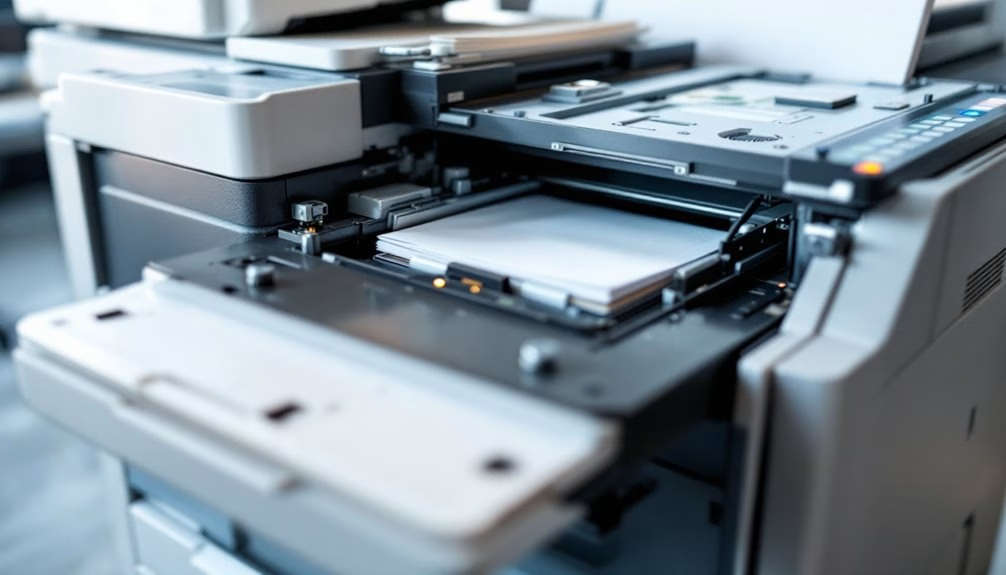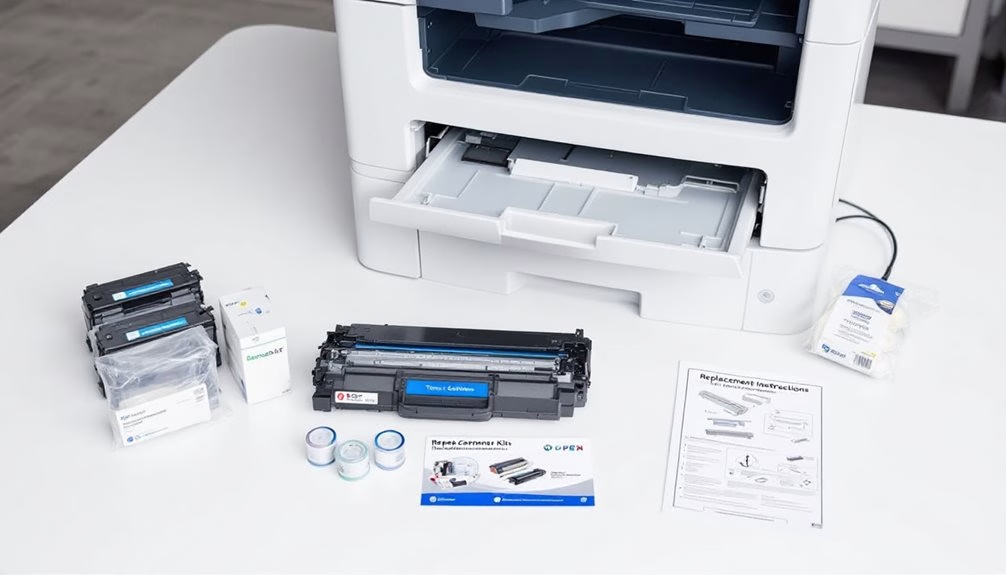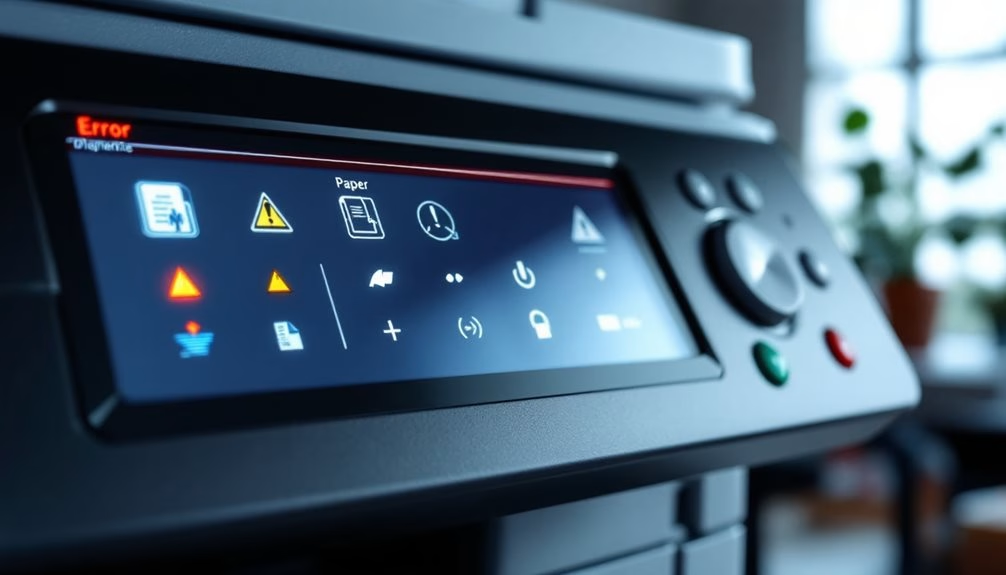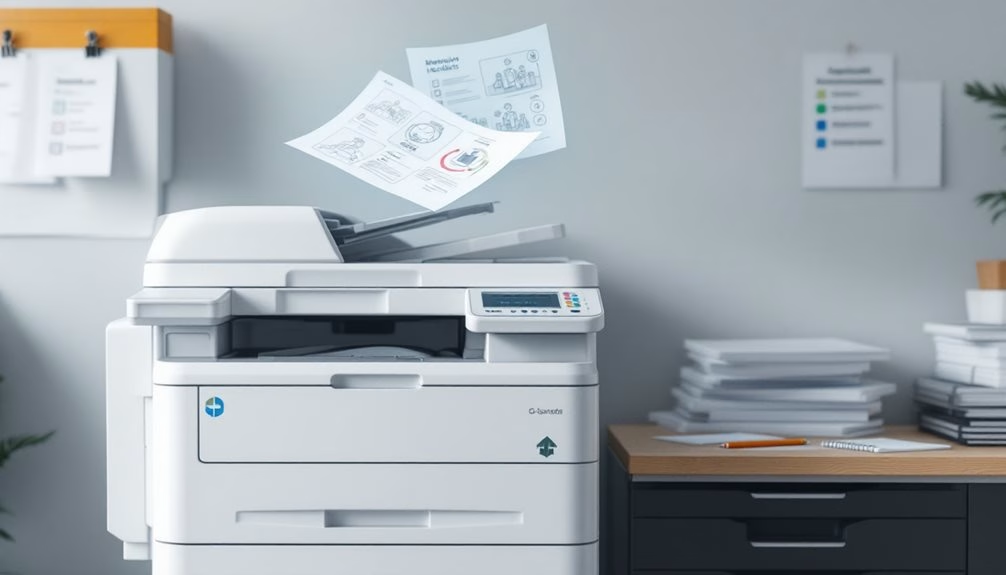We’ve all been there—standing helplessly beside a copier flashing error messages while an important deadline looms. Office equipment maintenance often falls to the bottom of our priority list until something breaks. Yet investing just minutes each day in simple copier care can prevent costly repairs and frustrating downtime. Let’s explore the essential practices that will keep your workhorse humming along smoothly when you need it most.
Expert Highlights
- Fan and properly align paper before loading to prevent jams and extend your copier’s lifespan.
- Clean glass surfaces daily with approved cleaners and perform monthly deep cleaning of internal components.
- Replace consumables promptly when prints appear faded or quality diminishes.
- Watch for warning signs like unusual noises, frequent jams, or streaks on prints.
- Train your team on proper operation and designate departmental “copier champions” for troubleshooting assistance.
Daily Habits That Prevent Paper Jams and Extend Lifespan

While many office workers simply power up copy machines without a second thought, implementing a few daily habits can dramatically reduce paper jams and extend your machine’s life.
We’ve found that fanning paper before loading trays prevents sheets from sticking together. Let’s also make checking paper alignment a team priority—misaligned stacks are jam magnets.
We should all wipe down the glass daily with approved cleaners. Remember to empty output trays regularly to prevent overflow issues.
Together, we can keep our shared equipment running smoothly by closing all panels properly after use and powering down machines overnight.
For optimal performance, consider scheduling preventive maintenance checks with factory-trained technicians who can identify potential issues before they cause equipment failure.
Monthly Cleaning Protocols for Optimal Print Quality

Although daily cleaning habits help maintain basic functionality, monthly deep cleaning protocols are crucial for preserving peak print quality and preventing costly repairs.
We recommend setting aside an hour each month for thorough cleaning. First, power down and unplug your machine. Gently wipe all glass surfaces with microfiber cloths and approved cleaning solution.
Next, vacuum paper dust from trays and accessible internal components. Don’t forget to clean the corona wires with alcohol swabs—these directly impact print quality.
Paper dust and debris are silent print quality killers—regular cleaning of internal components ensures optimal performance.
Most manuals include detailed diagrams for reaching hidden components. For optimal performance, consider scheduling preventive maintenance with factory-trained technicians who can provide a more comprehensive assessment and cleaning of your equipment.
When and How to Replace Key Consumable Components

Even the best-maintained copiers eventually require component replacement, which is why understanding both the timing and proper technique for installing new consumables saves your organization money and prevents workflow interruptions.
We’ve found that toner cartridges typically need replacement when prints appear faded, while drum units should be changed every 10,000-20,000 pages. Watch for image quality decline as your signal.
Waste toner containers need emptying when they’re 75% full.
When installing new components, always power down your machine first. Don’t force parts into place—they should fit smoothly. Remember to remove all packaging tabs and seals before installation.
We recommend keeping a small inventory of essential consumables to avoid downtime.
Whether you’re using copiers for commercial business settings or home-based operations, regular maintenance ensures optimal performance across all environments.
Recognizing Early Warning Signs of Potential Problems

Five key warning signs can help you identify copier problems before they escalate into costly repairs.
Watch for unusual noises like grinding or clicking, which often indicate mechanical issues.
Listen for grinding or clicking sounds coming from your copier—these are reliable warning signals of developing mechanical problems.
Paper jams occurring more frequently suggest feed rollers need cleaning or replacement.
Streaks or spots on prints point to dirty components or toner issues.
Notice if your machine runs hotter than usual, as overheating damages internal parts.
Finally, slower operation speed typically signals processing problems.
We’ve all faced the frustration of a copier breakdown during significant deadlines.
Implementing a preventative maintenance checklist can prevent up to 70% of common printer problems before they start.
Training Your Team on Proper Copier Operation Practices

While investing in routine maintenance is essential, properly training your team on correct copier operation practices forms the foundation of equipment longevity.
We’ve found that creating a simple one-page guide near each machine dramatically reduces user errors.
Let’s train everyone on paper loading techniques, clearing jams without damaging components, and using appropriate settings for different jobs.
Monthly mini-training sessions keep everyone’s knowledge fresh.
We recommend designating “copier champions” in each department who can assist colleagues with basic troubleshooting.
Our certified technicians are always available to provide additional training support to ensure your staff maintains optimal equipment performance.
Frequently Asked Questions
How Long Should a Typical Office Copier Last?
We’ve found office copiers typically last 5-7 years with proper maintenance. You’ll get the most from yours when you’re part of our community that values regular care and upkeep.
Can I Use Generic Toner Cartridges in My Branded Copier?
Yes, you can use generic cartridges in your branded copier. We recommend checking compatibility first, as some machines may reject them. Quality varies, so we’d suggest trying trusted aftermarket brands.
Should I Turn off My Copier Every Night?
We recommend turning off your copier nightly to extend its lifespan and save energy. For larger office machines, use sleep mode if you’ll need quick access in the morning.
What Causes Streaks or Shadows on My Copies?
We often see streaks or shadows when the drum unit’s worn out, there’s dirt on the scanner glass, or the toner’s low. Let’s clean those surfaces and check your supplies together.
How Do I Connect a New Copier to Our Office Network?
We’ll help you set up your new copier. First, connect it to your network with an Ethernet cable, then install printer drivers on all computers. Don’t forget to configure IP settings properly!
Expert Final Thoughts
We’ve covered the essential practices to keep your copier running smoothly for years to come. By implementing these daily habits, monthly maintenance routines, and timely component replacements, you’ll avoid costly breakdowns. Don’t ignore warning signs—they’re your first defense against serious issues. Remember, proper staff training is just as important as physical maintenance. With these strategies, we’re confident you’ll maximize your copier’s performance and lifespan.
About the Expert
Rafael M.
CEO of JR Copier
With over 35 years of hands-on experience in the copier and office printer industry, Rafael brings unparalleled expertise to every client interaction. His journey from service technician to CEO provides him with comprehensive understanding of all aspects of the business.
Areas of Expertise: Copier and printer sales, equipment leasing strategies, maintenance solutions, and managed print services. Rafael's deep industry knowledge ensures clients receive expert guidance, transparent pricing, and exceptional service for all their office equipment needs.
Connect on LinkedIn